TimTaiLieu.vn - Tài liệu, ebook, giáo trình, đồ án, luận văn
Tổng hợp tất cả tài liệu, ebook, giáo trình Khối Ngành Kinh Tế chọn lọc và hay nhất.

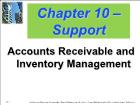 Bài giảng Financial Management - Chapter 10 – Support: Accounts Receivable and Inventory Management
Bài giảng Financial Management - Chapter 10 – Support: Accounts Receivable and Inventory ManagementExample of Relaxing Credit Standards The firm is currently producing a single product with variable costs of $20 and selling price of $25. Relaxing credit standards is not expected to affect current customer payment habits. Additional annual credit sales of $120,000 and an average collection period for new accounts of 3 months is expected. The ...
 11 trang | Chia sẻ: nguyenlinh90 | Ngày: 20/07/2019 | Lượt xem: 716 | Lượt tải: 0
11 trang | Chia sẻ: nguyenlinh90 | Ngày: 20/07/2019 | Lượt xem: 716 | Lượt tải: 0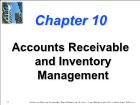 Bài giảng Financial Management - Chapter 10: Accounts Receivable and Inventory Management
Bài giảng Financial Management - Chapter 10: Accounts Receivable and Inventory ManagementAfter Studying Chapter 10, you should be able to: List the key factors that can be varied in a firm's credit policy and understand the trade-off between profitability and costs involved. Understand how the level of investment in accounts receivable is affected by the firm's credit policies. Critically evaluate proposed changes in credit policy...
 54 trang | Chia sẻ: nguyenlinh90 | Ngày: 20/07/2019 | Lượt xem: 935 | Lượt tải: 0
54 trang | Chia sẻ: nguyenlinh90 | Ngày: 20/07/2019 | Lượt xem: 935 | Lượt tải: 0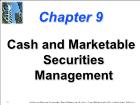 Bài giảng Financial Management - Chapter 9: Cash and Marketable Securities Management
Bài giảng Financial Management - Chapter 9: Cash and Marketable Securities ManagementAfter Studying Chapter 9, you should be able to: List and explain the motives for holding cash. Understand the purpose of efficient cash management. Describe methods for speeding up the collection of accounts receivable and methods for controlling cash disbursements. Differentiate between remote and controlled disbursement, and discuss any et...
 60 trang | Chia sẻ: nguyenlinh90 | Ngày: 20/07/2019 | Lượt xem: 923 | Lượt tải: 0
60 trang | Chia sẻ: nguyenlinh90 | Ngày: 20/07/2019 | Lượt xem: 923 | Lượt tải: 0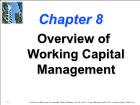 Bài giảng Financial Management - Chapter 8: Overview of Working Capital Management
Bài giảng Financial Management - Chapter 8: Overview of Working Capital ManagementAfter Studying Chapter 8, you should be able to: Explain how the definition of "working capital" differs between financial analysts and accountants. Understand the two fundamental decision issues in working capital management – and the trade-offs involved in making these decisions. Discuss how to determine the optimal level of current assets. ...
 26 trang | Chia sẻ: nguyenlinh90 | Ngày: 20/07/2019 | Lượt xem: 669 | Lượt tải: 0
26 trang | Chia sẻ: nguyenlinh90 | Ngày: 20/07/2019 | Lượt xem: 669 | Lượt tải: 0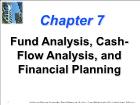 Bài giảng Financial Management - Chapter 7: Fund Analysis, Cash-Flow Analysis, and Financial Planning
Bài giảng Financial Management - Chapter 7: Fund Analysis, Cash-Flow Analysis, and Financial PlanningAfter Studying Chapter 7, you should be able to: Explain the difference between the flow of funds (sources and uses of funds) statement and the statement of cash flows – and understand the benefits of using each. Define "funds" and identify sources and uses of funds. Create a sources and uses of funds statement, make adjustments, and analyze t...
 59 trang | Chia sẻ: nguyenlinh90 | Ngày: 20/07/2019 | Lượt xem: 696 | Lượt tải: 0
59 trang | Chia sẻ: nguyenlinh90 | Ngày: 20/07/2019 | Lượt xem: 696 | Lượt tải: 0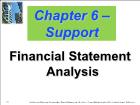 Bài giảng Financial Management - Chapter 6 –Support: Financial Statement Analysis
Bài giảng Financial Management - Chapter 6 –Support: Financial Statement AnalysisRemember? Common-size Analysis An analysis of percentage financial statements where all balance sheet items are divided by total assets and all income statement items are divided by net sales or revenues.
 13 trang | Chia sẻ: nguyenlinh90 | Ngày: 20/07/2019 | Lượt xem: 744 | Lượt tải: 0
13 trang | Chia sẻ: nguyenlinh90 | Ngày: 20/07/2019 | Lượt xem: 744 | Lượt tải: 0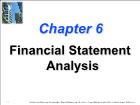 Bài giảng Financial Management - Chapter 6: Financial Statement Analysis
Bài giảng Financial Management - Chapter 6: Financial Statement AnalysisAfter Studying Chapter 6, you should be able to: Understand the purpose of basic financial statements and their contents. Understand what is meant by “convergence” in accounting standards. Explain why financial statement analysis is important to the firm and to outside suppliers of capital. Define, calculate, and categorize (according to liqu...
 70 trang | Chia sẻ: nguyenlinh90 | Ngày: 20/07/2019 | Lượt xem: 659 | Lượt tải: 0
70 trang | Chia sẻ: nguyenlinh90 | Ngày: 20/07/2019 | Lượt xem: 659 | Lượt tải: 0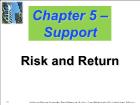 Bài giảng Financial Management - Chapter 5 – Support: Risk and Return
Bài giảng Financial Management - Chapter 5 – Support: Risk and ReturnDiscrete Distribution: Expected Return and Variance Calculation As you can see we have recreated the discrete distribution here in Excel. The probabilities must sum to 1 or 100% and when we multiply the individual expected returns in each state by the associated probability we generate the contribution that state has to the overall expected retu...
 15 trang | Chia sẻ: nguyenlinh90 | Ngày: 20/07/2019 | Lượt xem: 720 | Lượt tải: 0
15 trang | Chia sẻ: nguyenlinh90 | Ngày: 20/07/2019 | Lượt xem: 720 | Lượt tải: 0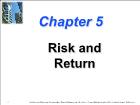 Bài giảng Financial Management - Chapter 5: Risk and Return
Bài giảng Financial Management - Chapter 5: Risk and ReturnAfter studying Chapter 5, you should be able to: Understand the relationship (or “trade-off”) between risk and return. Define risk and return and show how to measure them by calculating expected return, standard deviation, and coefficient of variation. Discuss the different types of investor attitudes toward risk. Explain risk and return in a ...
 57 trang | Chia sẻ: nguyenlinh90 | Ngày: 20/07/2019 | Lượt xem: 791 | Lượt tải: 0
57 trang | Chia sẻ: nguyenlinh90 | Ngày: 20/07/2019 | Lượt xem: 791 | Lượt tải: 0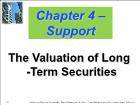 Bài giảng Financial Management - Chapter 4 – Support: The Valuation of Long-Term Securities
Bài giảng Financial Management - Chapter 4 – Support: The Valuation of Long-Term SecuritiesBond C has a $1,000 face value and provides an 8% annual coupon for 30 years. The appropriate discount rate is 10%. What is the value of the coupon bond? Where V = $811 (rounded answer). Well, we can use our knowledge of TVM from Chapter 3. The value of a bond has been shown to be the present value of the coupon payments (an annuity) and the futu...
 23 trang | Chia sẻ: nguyenlinh90 | Ngày: 20/07/2019 | Lượt xem: 766 | Lượt tải: 0
23 trang | Chia sẻ: nguyenlinh90 | Ngày: 20/07/2019 | Lượt xem: 766 | Lượt tải: 0
Website đang trong thời gian thử nghiệm, chờ xin giấy phép của Bộ TT & TT.

